On the night of Friday 26th-Saturday 27th November 2021, a major storm, called Storm Arwen by meteorologists, hit the east coast of Scotland with very strong winds of up to 90 mph. Unusually, the wind direction came from the northeast (most of the country’s stormy weather comes from the southwest) and this resulted in many trees being blown down in exposed areas.
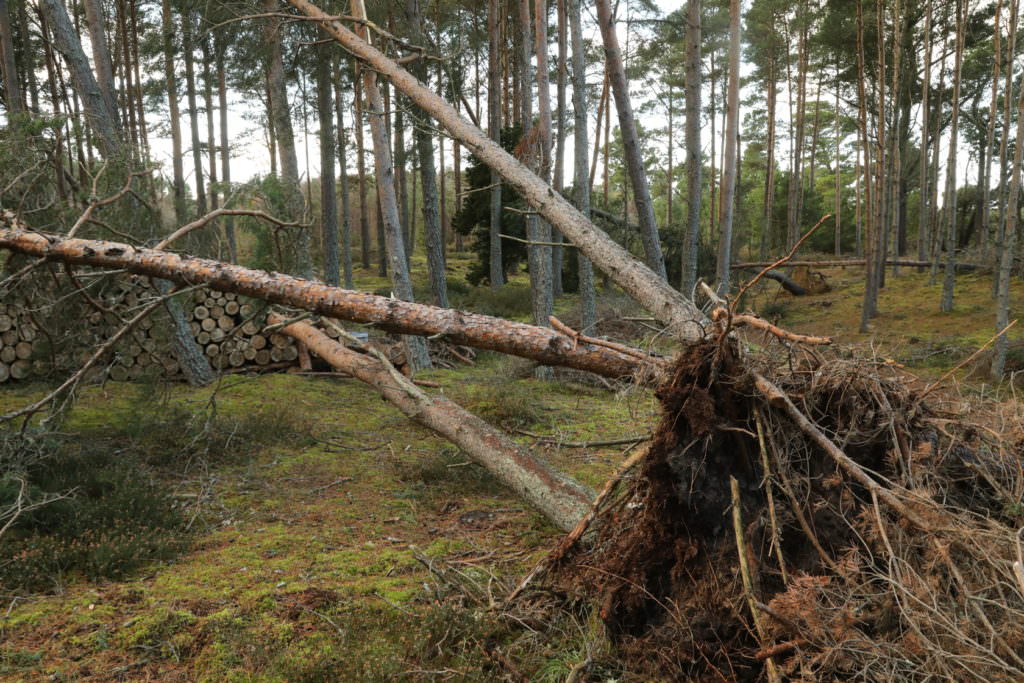
Scots pines (Pinus sylvestris) blown down over a stack of cut logs by Storm Arwen on the night of 26th November 2021, Findhorn Hinterland.
Here at the Findhorn Hinterland over 100 large trees were uprooted and blown over, with most of those being in the northeast corner of the pine plantation, closest to the wind turbines. They were the trees that were most exposed to the direction the wind came from, and because they were tall and straight and had grown close to each other they were quite vulnerable to exceptionally strong winds like this. A few trees even got snapped off in the middle of their trunks by the sheer force of the gales they were subjected to.
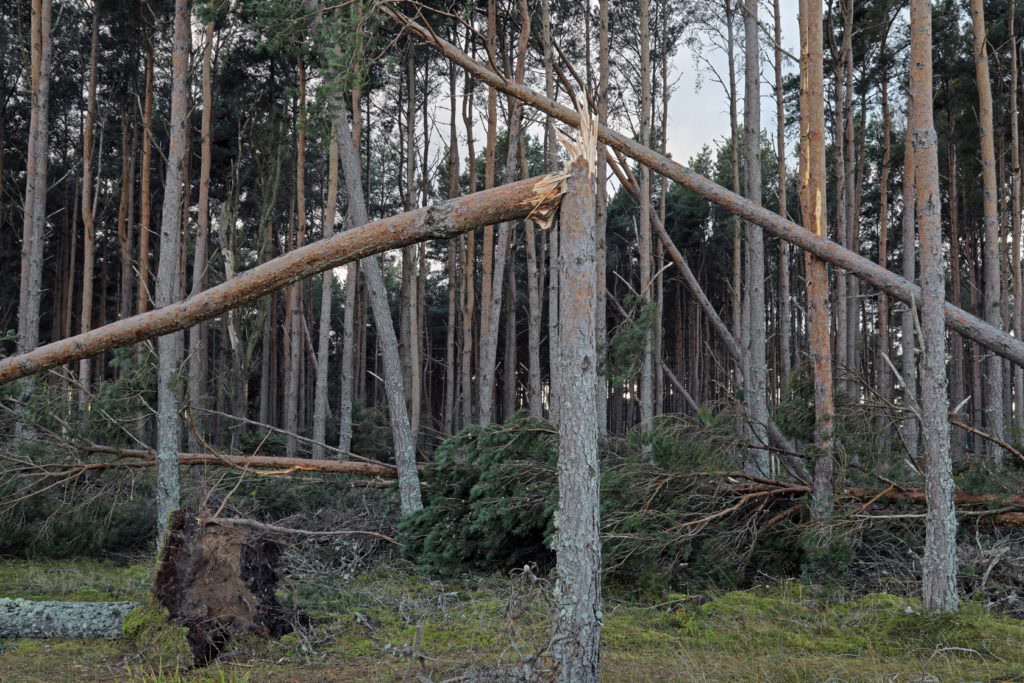
Scots pines (Pinus sylvestris) blown down, & one pine snapped in half, by Storm Arwen on the night of 26th November 2021, Findhorn Hinterland.
While the first thought that many people may have had is that this was a ‘disaster’ and very bad for the woodland, it is in fact a relatively common occurrence that brings its own benefits for the ecosystem. It is an example of what is known in ecological terms as ‘natural disturbance’, and is one of several irregular events that create change in the ecosystem. Other examples include naturally-occurring forest fires, occasional outbreaks of insect infestations and unusually cold winter conditions. All of these have similar effects in that they disturb the status quo in the ecosystem, and create heterogeneity, or variation, where before there may have been uniformity.
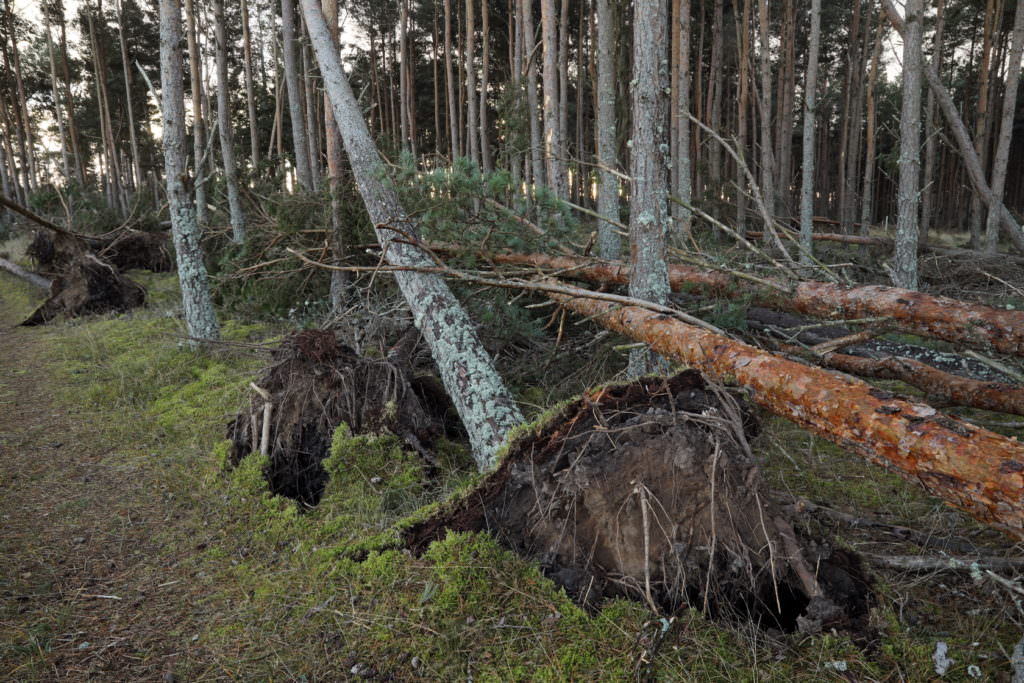
Scots pines (Pinus sylvestris) blown down by Storm Arwen on the night of 26th November 2021, Findhorn Hinterland.
With Storm Arwen, while it’s obviously sad to see the trees that have been blown down, one immediate result of that is the creation of light gaps in the otherwise relatively dense and evenly shaded areas under the pines in the woodland. These light gaps provide the ideal opportunity for pioneer species which need lots of light to grow, and they quickly become established after such an event. In 2004 an even stronger storm blew down a much larger area of the pine woodland on the Hinterland, which we now call the Fallen Acres. In the following two years foxgloves blossomed in profusion there, and they were followed by prolific regeneration of silver birches. In fact those were so dense that we have done regular work since then to thin them out, and the area is now a beautiful young birch woodland.
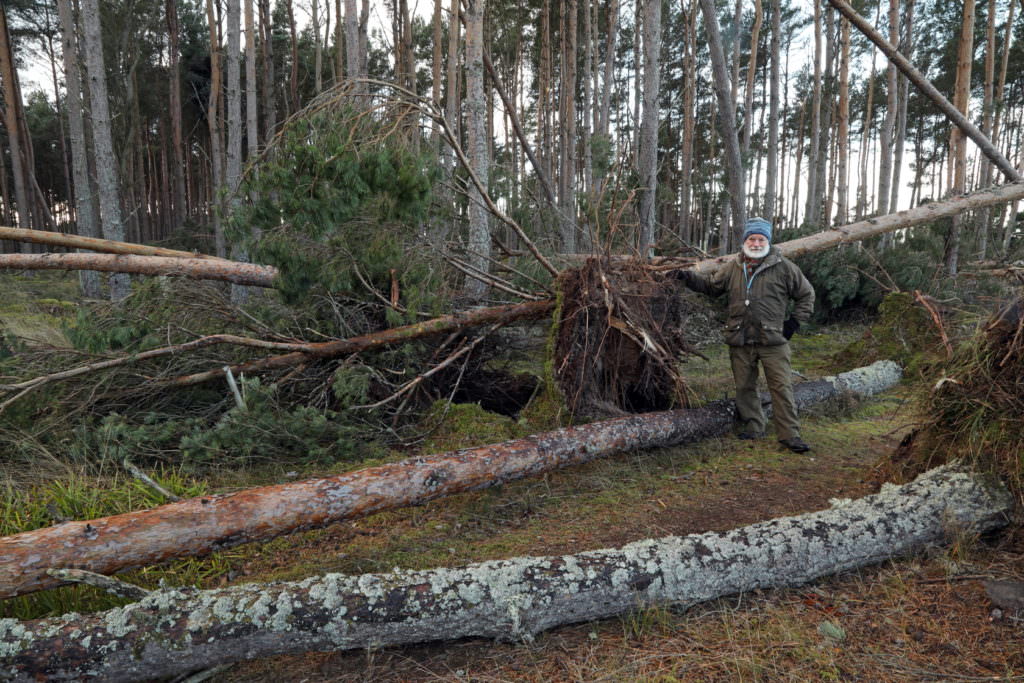
Alan with some of the Scots pines (Pinus sylvestris) blown down by Storm Arwen on the night of 26th November 2021, Findhorn Hinterland.
Other results of this natural disturbance include the creation of micro-habitats that can be utilised by small mammals, various invertebrates etc. A good example are the upturned root plates of the fallen trees and the bare soil that is exposed underneath them. Saprotrophic fungi of course have a literal field day, as they have a lot of newly-dead wood to feed on and decompose, releasing the nutrients stored there and making them available for other organisms in the soil.
For me, it’s part of the rewilding of both the land and ourselves to see the positive side of an event like Storm Arwen, and to recognise the benefits it can bring to many parts of our local ecosystem.
Alan Watson Featherstone
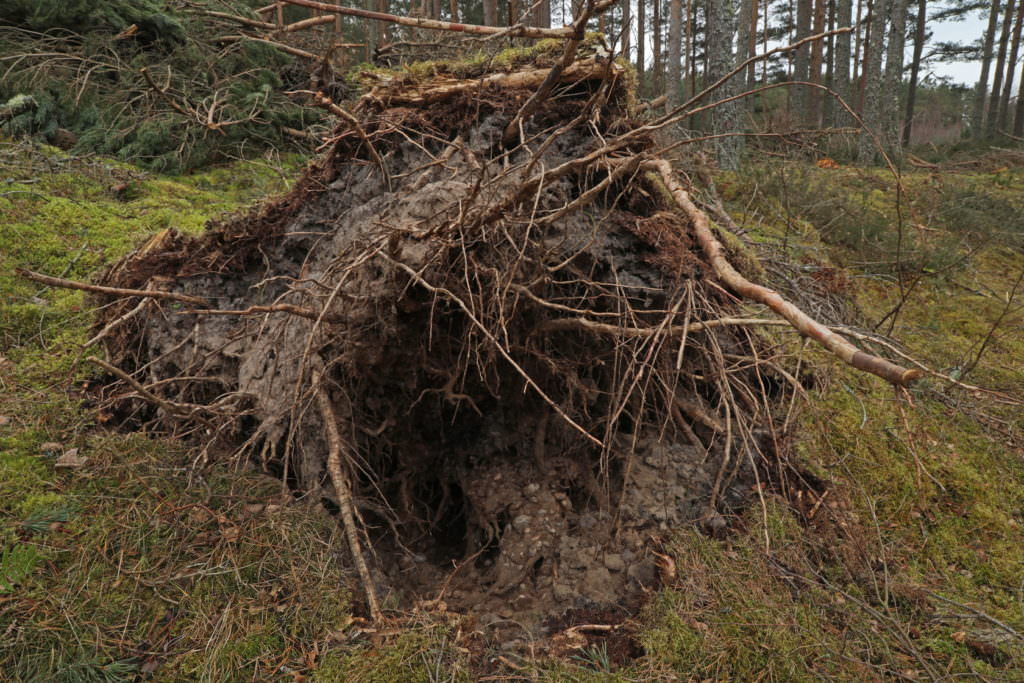
Upturned root plate of a Scots pine (Pinus sylvestris) blown down by Storm Arwen, showing the sandy nature of the soil, Findhorn Hinterland.




Storm Arwen – natural disturbance in action
On the night of Friday 26th-Saturday 27th November 2021, a major storm, called Storm Arwen by meteorologists, hit the east coast of Scotland with very strong winds of up to 90 mph. Unusually, the wind direction came from the northeast (most of the country’s stormy weather comes from the southwest) and this resulted in many trees being blown down in exposed areas.
Scots pines (Pinus sylvestris) blown down over a stack of cut logs by Storm Arwen on the night of 26th November 2021, Findhorn Hinterland.
Here at the Findhorn Hinterland over 100 large trees were uprooted and blown over, with most of those being in the northeast corner of the pine plantation, closest to the wind turbines. They were the trees that were most exposed to the direction the wind came from, and because they were tall and straight and had grown close to each other they were quite vulnerable to exceptionally strong winds like this. A few trees even got snapped off in the middle of their trunks by the sheer force of the gales they were subjected to.
Scots pines (Pinus sylvestris) blown down, & one pine snapped in half, by Storm Arwen on the night of 26th November 2021, Findhorn Hinterland.
While the first thought that many people may have had is that this was a ‘disaster’ and very bad for the woodland, it is in fact a relatively common occurrence that brings its own benefits for the ecosystem. It is an example of what is known in ecological terms as ‘natural disturbance’, and is one of several irregular events that create change in the ecosystem. Other examples include naturally-occurring forest fires, occasional outbreaks of insect infestations and unusually cold winter conditions. All of these have similar effects in that they disturb the status quo in the ecosystem, and create heterogeneity, or variation, where before there may have been uniformity.
Scots pines (Pinus sylvestris) blown down by Storm Arwen on the night of 26th November 2021, Findhorn Hinterland.
With Storm Arwen, while it’s obviously sad to see the trees that have been blown down, one immediate result of that is the creation of light gaps in the otherwise relatively dense and evenly shaded areas under the pines in the woodland. These light gaps provide the ideal opportunity for pioneer species which need lots of light to grow, and they quickly become established after such an event. In 2004 an even stronger storm blew down a much larger area of the pine woodland on the Hinterland, which we now call the Fallen Acres. In the following two years foxgloves blossomed in profusion there, and they were followed by prolific regeneration of silver birches. In fact those were so dense that we have done regular work since then to thin them out, and the area is now a beautiful young birch woodland.
Alan with some of the Scots pines (Pinus sylvestris) blown down by Storm Arwen on the night of 26th November 2021, Findhorn Hinterland.
Other results of this natural disturbance include the creation of micro-habitats that can be utilised by small mammals, various invertebrates etc. A good example are the upturned root plates of the fallen trees and the bare soil that is exposed underneath them. Saprotrophic fungi of course have a literal field day, as they have a lot of newly-dead wood to feed on and decompose, releasing the nutrients stored there and making them available for other organisms in the soil.
For me, it’s part of the rewilding of both the land and ourselves to see the positive side of an event like Storm Arwen, and to recognise the benefits it can bring to many parts of our local ecosystem.
Alan Watson Featherstone
Upturned root plate of a Scots pine (Pinus sylvestris) blown down by Storm Arwen, showing the sandy nature of the soil, Findhorn Hinterland.